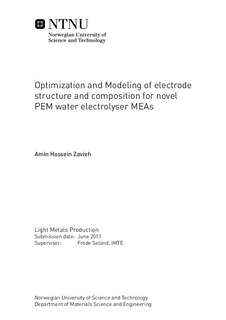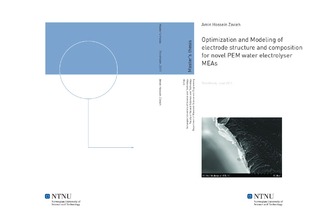| dc.contributor.advisor | Seland, Frode | nb_NO |
| dc.contributor.author | Hossein Zavieh, Amin | nb_NO |
| dc.date.accessioned | 2014-12-19T13:25:58Z | |
| dc.date.available | 2014-12-19T13:25:58Z | |
| dc.date.created | 2012-04-20 | nb_NO |
| dc.date.issued | 2011 | nb_NO |
| dc.identifier | 517089 | nb_NO |
| dc.identifier | ntnudaim:6510 | nb_NO |
| dc.identifier.uri | http://hdl.handle.net/11250/248963 | |
| dc.description.abstract | Lack of commercial electrocatalysts and membrane electrode assemblies (MEA) which are efficient, durable and reasonably priced for proton exchange membrane water electrolysis was the inspiration of the current project.A reliable, reproducible and optimized membrane electrode assembly preparation protocol for water electrolysis was developed, with emphasis on the oxygen evolution electrode. The MEAs comprised of a Nafion® 115 membrane with commercially available 20 wt% Pt on carbon and in-house synthesized 20 wt% Ir on antimony tin-oxide, manually sprayed onto the membrane using an airbrush, and functioning as the hydrogen and oxygen evolution catalysts, respectively. A current density of 2.1 A/cm2 was obtained at a cell voltage of 1.85 V and 80 °C.In-situ electrochemical characterization such as steady state polarization and cyclic voltametry was performed on the MEAs to be able to predict performance in stationary applications. Effect of loading on cell performance at different cell voltages was studied and 0.8 mgIr/cm2 loaded MEA showed the highest current at 1.85V. Furthermore, cross section and morphology of the catalyst was studied using SEM and TEM. The catalyst layer thickness found to be from 2 to 5 µm for 0.4 to 1.0 mgIr/cm2 loadings.A theoretical one-dimensional model was proposed for current and reaction rate distribution through the catalyst layer. Since the conductivity of the catalyst measured to be higher than Nafion, model shoed at high loadings and potentials (or catalyst layer thicknesses) reaction tends to happen mostly near the membrane while at low loadings and potentials reaction rate is uniform though the layer. In addition, model was compared to experimental data and shown it is reliable for low potentials but it needs some correction for high potential due decrease in specific active area per volume by reducing thickness of the layer and not taking other factors than Tafel polarization into consideration.Introducing accelerated degradation protocol, durability of the catalyst was studied and corrected by subtracting ohmic losses due oxidation and etc. The loss for accelerated degradation found to be 0.3 mV/h. Then structure of the MEA cross-section was investigated using TEM after degradation test so major cause of the loss in performance found to be migration of Iridium nano particles into the membrane | nb_NO |
| dc.language | eng | nb_NO |
| dc.publisher | Institutt for materialteknologi | nb_NO |
| dc.subject | ntnudaim:6510 | no_NO |
| dc.subject | MSLIMETAL Light Metals Production | no_NO |
| dc.subject | | no_NO |
| dc.title | Optimization and Modeling of electrode structure and composition for novel PEM water electrolyser MEAs | nb_NO |
| dc.type | Master thesis | nb_NO |
| dc.source.pagenumber | 66 | nb_NO |
| dc.contributor.department | Norges teknisk-naturvitenskapelige universitet, Fakultet for naturvitenskap og teknologi, Institutt for materialteknologi | nb_NO |

